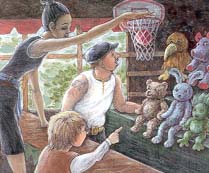|
________________
CM . . . .
Volume VI Number 3 . . . . October 1, 1999
excerpt: Stretch was not like other people. She was very tall. Not only that, she could stretch her body taller than the tallest tree. Stretch was kind too, but people only saw that she was different. Now, one night, some children vanished from their homes. No explanation, no clues, they simply disappeared. People were frightened. And who did they blame? One look at Stretch and they decided she had something to do with it. They greeted her with silence. They whispered behind her back. Finally, unhappy and hurt, Stretch ran away into the forest.  Using a beloved folktale from her native Czechoslovakia, Charles has created a politically-correct
variant about tolerance, determination and friendship. The story centers around three
multi-cultural women who each have amazing abilities. Stretch can extend her body, Swallow can
ingest huge quantities, and Stare's strong eyes can burn through anything. Considered social
misfits, they are ostracized by the villagers who fear and ridicule these unusual-looking women.
Joining forces to help young Ira locate his missing sister, they then thwart an evil wizard by
combining their talents. All ends cheerfully as they prepare to return the missing children freed
with the wizard's departure. Although the three realize they won't be welcome for long, they are
content with their newfound friendship.
Using a beloved folktale from her native Czechoslovakia, Charles has created a politically-correct
variant about tolerance, determination and friendship. The story centers around three
multi-cultural women who each have amazing abilities. Stretch can extend her body, Swallow can
ingest huge quantities, and Stare's strong eyes can burn through anything. Considered social
misfits, they are ostracized by the villagers who fear and ridicule these unusual-looking women.
Joining forces to help young Ira locate his missing sister, they then thwart an evil wizard by
combining their talents. All ends cheerfully as they prepare to return the missing children freed
with the wizard's departure. Although the three realize they won't be welcome for long, they are
content with their newfound friendship.
Charles has attempted to strike a balance between a strong traditional story and a desire to denounce society's preoccupation with female body types. In my view, she is not entirely successful. While good does triumph over evil and the underdog(s) wins, the happy ending is undermined by the realization that acceptance is not assured. This conclusion may be realistic in real life settings, but, in fairytales, one expects heroic efforts to receive undying gratitude. Her female characters represent a variety of cultures - Black, Caucasian and Asian - but how they came to be amongst villagers of indeterminate race is not revealed. Her language is also unexceptional. She recounts the events in a fairly direct manner, employing a repetitive structure initially, but then abandoning it. In comparison, her illustrations are well-crafted and aptly convey the variety of emotions experienced by the characters. She chooses not to picture the wizard but uses huge shadows and fearful faces, which makes him all the more menacing. In her attempt to present positive role models for girls, however, she misses the mark in her illustration of the enormous Swallow eating gluttonously at the town fair. Recommended with reservations. Alison Mews is the Director of the Curriculum Materials Centre, Faculty of Education, Memorial University of Newfoundland in St. John's, NF.
To comment on this title or this review, send mail to cm@umanitoba.ca.
Copyright © the Manitoba Library Association.
Reproduction for personal use is permitted only if this copyright notice
is maintained. Any other reproduction is prohibited without
permission.
Published by
TABLE OF CONTENTS FOR THIS ISSUE - October 1, 1999.
AUTHORS |
TITLES |
MEDIA REVIEWS |
PROFILES |
BACK ISSUES |
SEARCH |
CMARCHIVE |
HOME
|
